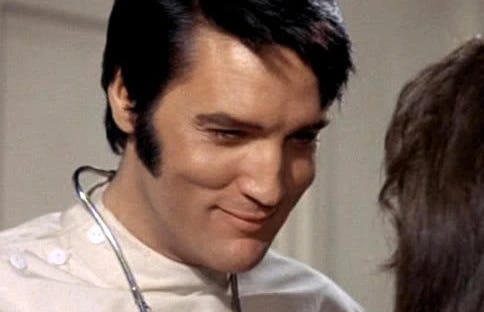The First Film to Deal Explicitly with Autism Was Also Elvis' Last Movie/Mind-bogglingly offensive
The first explicit depiction of autism in film was also the final Elvis Presley vehicle. If autism seems like a strange subject for an Elvis movie, you’re right! Change of Habit is a surreal endeavor that aspires to Stanley Kramer yet lacks the intellectual heft and substance of Blue Hawaii.
Elvis Presley solves the problems of the ghetto and cures a little girl of her autism by hugging her tightly and telling her he loves her in an appalling insult to autism that sets an unfortunate precedent for depictions of the condition that are both inaccurate and dangerous.
Change of Habit has one of the stranger credits in Elvis’ checkered filmography: pioneering quack Dr. Robert Zaslow is listed as a consultant on the Rage Reduction sequence.
What is Rage Reduction? It is a now discredited pseudo-scientific theory that autism was caused by failures in the attachment relationship with mothers. This proved not to be true, but it may or may not be worth mentioning that my mother abandoned me as a baby. I consequently had difficulty connecting with people emotionally or trusting others.
In Change of Habit, Rage Reduction takes the form of a sequence where Amanda (Lorena Kirk), a seemingly mute and possibly deaf little girl, is held tightly by a moonlighting nun out of habit and a crooning inner-city doctor, both of whom repeatedly tells her how much they love her.
That might seem dubious at best and dangerous at worst. Attachment therapy/Rage reduction has resulted in numerous deaths en route to being discredited, but it was cutting edge when Change of Habit gave movie audiences their first glimpse at someone explicitly demarcated as autistic.
It nevertheless works wonders. Change of Habit is a product of a long ago time when autism was seen less as a condition than a disease that could and should be cured through controversial techniques like rage therapy.
Amanda was previously so nonverbal that people thought she was deaf, but it isn’t long before she’s tossing off words left and right, imitating hilariously inappropriate statements by others, a process known as Echolalia, and telling her saintly helpers, “Love you.”
When prompted in song by Elvis, this previously sad and silent little girl even smiles.
Change of Habit isn’t serious or smart enough to handle anything, but that somehow does not keep it from trying to handle everything: race relations, feminism, sexual assault, changes within the Catholic Church, and black power, just for starters.
In what is less a role than an unforgivable insult, Mary Tyler Moore plays Michelle Gallagher. She’s a newfangled kind of nun who wants to follow in Christ’s footsteps and spread the gospel to those on the very bottom of the socioeconomic ladder.
This forward-thinking woman of God thinks that wearing a nun’s habit of oppressive religious authority would only get in the way of being able to really connect with the suffering souls of the ghetto. So she decides to go to work at an inner-city clinic alongside Sister Barbara (Jane Eliot) and Sister Irene (Barbara McNair), two other nun colleagues, without telling anyone that they’re nuns dressed like everyday people.
The clinic is run by cynical yet compassionate singing Dr. John Carpenter (Elvis Presley). Yes, John Carpenter. Just like the famous musician and Bob Crane’s creepy friend.
Elvis’ inner-city savior makes a less-than-glowing impression when he meets the gals. First, he assumes that one or all of them is pregnant, possibly by the same man.
When they correct him, he assumes they’re all Park Avenue debutantes. “The last three nurses couldn’t take it. Two of them got raped: one of them against their will,” the doctor quips.
Dr. John Carpenter says of Sister Irene, whom, it should be noted, is black, which only figures into every word she says and scene she’s in. “A girl like that should get married and raise a whole bunch of kids, turn her hang-ups into something worthwhile. In fact, I’d prescribe that for all three of you.”
After the good doctor makes his little rape joke and prescribes marriage and motherhood as the cure for any woman’s existential blues, Mary knows that she must be with this awful chauvinist even though, as a nun, she’s a Bride of Christ.
Dr. Carpenter thinks women should be pregnant, barefoot, and swinging from his ding-a-ling, but he comes to respect Mary and her expertise when she correctly diagnoses Amanda as being autistic rather than deaf.
“Sometimes when a child is rejected early in life, they crawl inside themselves and shut out the whole world, as if they’re trying to punish the rest of us along with themselves,” Sister Michelle explains in a rough summary of how attachment therapy works.
Again, this has been wholly discredited, but I was rejected early in life, so I crawled inside myself and shut out the whole world. I also recently learned that I am autistic.
Sister Barbara wants to treat Amanda with patience, love, and understanding. The doctor sees Rage Reduction as a real time and energy saver.
First, Dr. Carpenter does this THING where he rips away Amanda’s beloved doll and holds her tightly while he drawls, “I’m gonna hold you til you get rid of all your hate. Get as mad as you can.”
The doctor and his head nurse alternate between baiting the traumatized little girl to get angry and aggressive and telling her that they love her. John and Barbara physically restrain poor Amanda as she screams and cries out in pain and confusion.
This was at one point considered a groundbreaking and effective way to treat autism. In a related development, many children have died through this process. That’s one of the reasons that it has been discredited.
That’s all it takes to get Amanda talking. Why she’s saying, “Love you” in no time at all!
Amanda rocks. She doesn’t make eye contact and hates to be touched or held, but after experiencing the cruel gauntlet of Rage Reduction, she’s reborn. She’s giving Dr. Elvis, PhD a big old hug and having fun at an amusement park.
Normally, Carpenter would prescribe getting married and raising a whole bunch of kids for Amanda, but she’s a child, so he switches tactics and goes with Rage Reduction.
The undercover nuns with the contemporary flair are seen as hussies and ladies of ill repute because they are not married, nor do they wear nun’s habits, but that does not keep them from fixing the ghetto all the same.
These passionate idealists take on all of the ills of the inner city, from a corpulent, sunglasses-wearing loan shark to a shopkeeper who fleeces his customers to a parish priest who treats the women as if they are his hated enemies and not an ally in spreading the gospel of Christ.
Sister Barbara may have taken a vow of celibacy, but her boss at the clinic is persistent in his efforts to have sex with her. He does not know she is a secret nun, but I’m not sure it would have mattered.
Elvis is a legendarily charismatic, magnetic figure cast here as a living Saint who has devoted his life to serving humanity. So why is he so perversely, pervasively unlikable?
Dr. John Carpenter becomes less sexist as Change of Habit progresses, but that’s mainly because it would be difficult, if not impossible, to sustain such a high level of misogyny.
Late in the film, Mary is rewarded for her selfless efforts to save the denizens of the inner city with a sexual assault attempt by one of the clinic’s patients. The scene drags on interminably and begs unsuccessfully for the cutting room floor, but American filmmakers were inexplicably in love with gratuitous rape scenes throughout the late 1960s and 1970s. The thinking wasn’t, “Why on earth would a rape scene be here?” But rather, “Why shouldn’t we include a rape here? What movie isn’t improved by filmed depictions of sexual assault?”
Everything is wrong with Change of Habit, including its handling of autism. It’s easy to see why Elvis wouldn’t want to go on acting in movies when this was the kind of material he had. This was Elvis’ final film. He did not go out on a high note but rather with the type of world-class stinker you would need to be high to enjoy.












So she’s… nundercover.
Elvis really was a pioneer. He made an insulting inaccurate movie about autism DECADES before Sia!